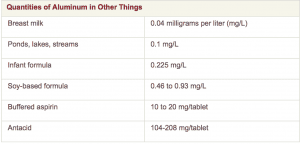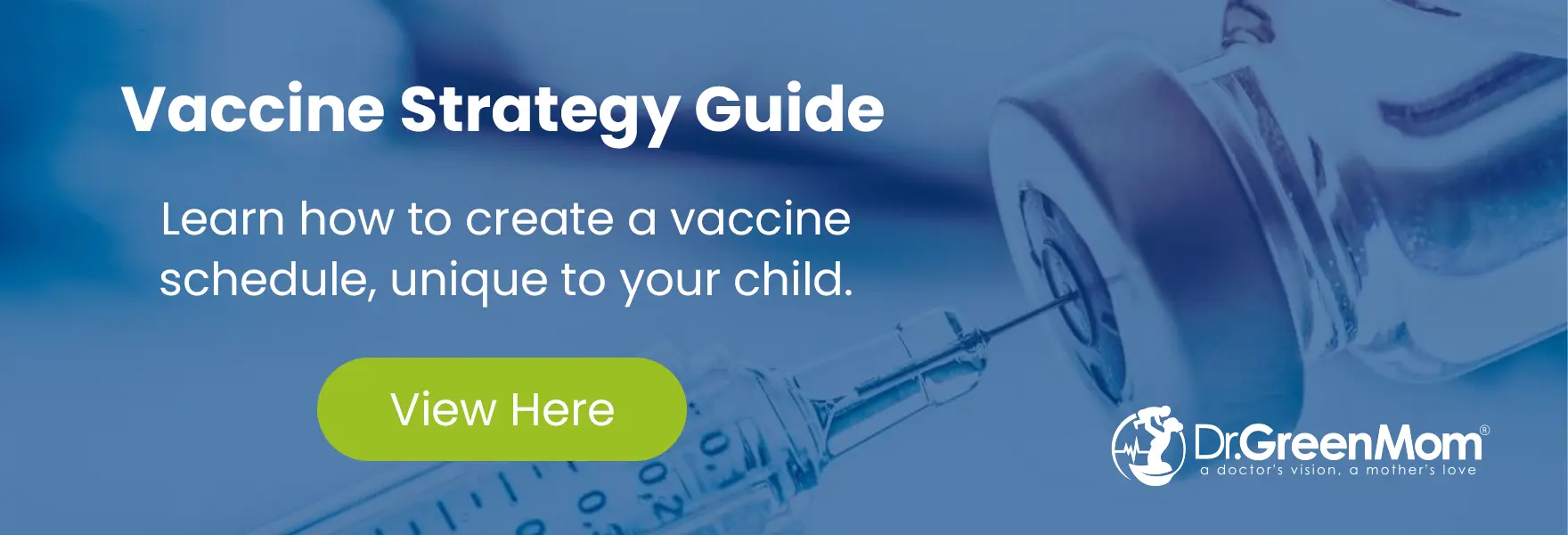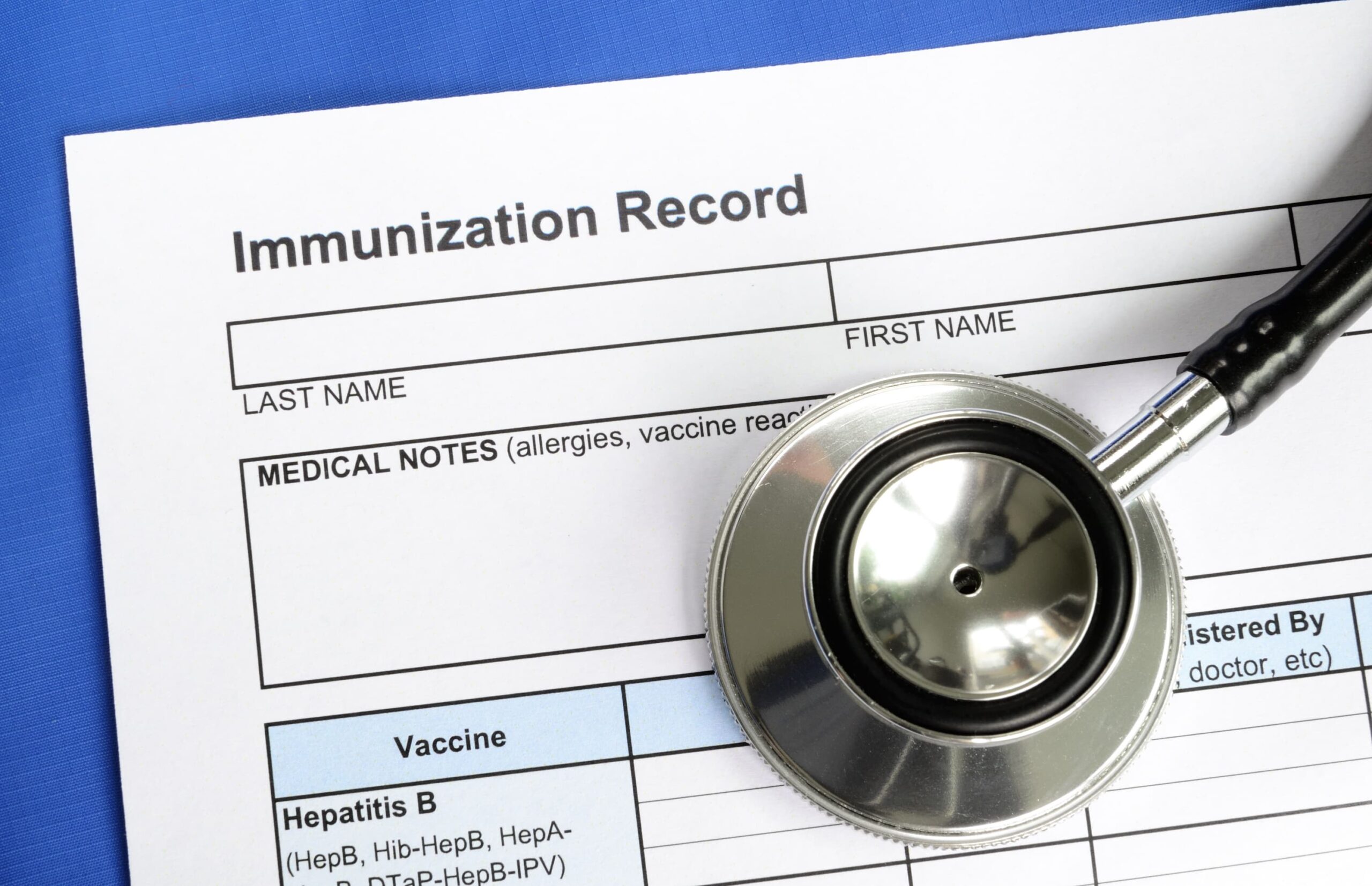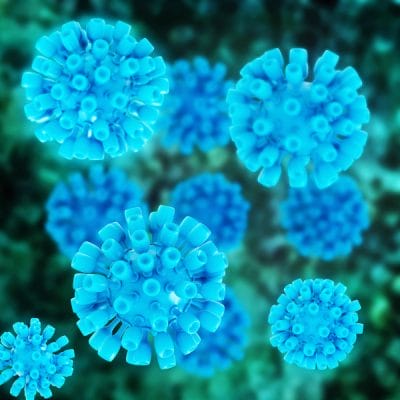Ingredients, Excipients, Additives, Adjuvents:
- Egg Protein
- Human Cell Lines (HeLa, MRC-5, PER.C6, WI-38)
- Detergents (Deoxycholate, Triton X-100, Taurodeoxycholic acid sodium salt, Polysorbate 80, Polysorbate 20)
- Formaldehyde
- Formalin
- Gelatin
- Glutaraldehyde
- Latex
- Mercury
- Aluminum
- Monosodium Glutamate
- 2-phenoxyethanol
- Antibiotics
- Antimicrobials
- ASo2, ASo3, AS04
- CpG (synthetic DNA)
- Monophosphoryl Lipid A (MPL)
- Squalene- MF59
CDC, FDA, and Resources:
- Vaccine Components Table
- Vaccine Package Inserts & Manufacturers
- Vaccine Ingredient Safety Citations (CDC)
- Vaccine Ingredient Resources
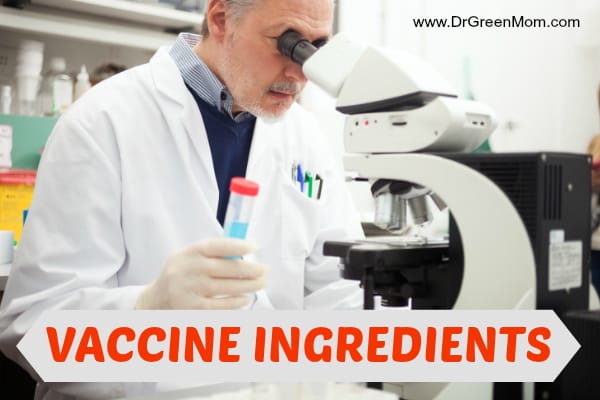
How Vaccines Are Made
- a suspending fluid (sterile water, saline, or fluids containing protein)
- preservatives and stabilizers (for example, albumin, phenols, and glycine)
- adjuvants or enhancers that help improve the vaccine’s effectiveness
- very small amounts of the culture material used to grow the virus or bacteria used in the vaccine, such as chicken egg protein. (1)
- Here is information to understand the process of how vaccines are made.
Vaccines That Contain Potential Allergens
- Vaccine Allergens per 0.5mL (updated Sept 2016)
Potential Allergens as Vaccine Ingredients:
- Amphotericin B
- Casein (Bovine)
- Chlortetracyclin
- Ovalbumin (Egg)
- Gelatin (Bovine)
- Gelatin (Porcine)
- Gentamicin Sulfate
- Latex
- Neomycin
- Ovalbumin
- Polymyxin B
- Serum Fetal Bovine
- Sodium taurodeoxycholate
- Streptomycin
- Thimerosal
- Yeast
Ingredients in Each Vaccine
- Vaccine Excipient & Media Summary – Excipients Included in U.S. Vaccines, by Vaccine (updated 2/15)
- Vaccine Excipients per 0.5mL (updated 3/26/13)
- Vaccine Ingredient Summary – CDC (2010, has info regarding all human cell lines, monkey kidney cells, etc)
INGREDIENTS, EXCIPIENTS, ADDITIVES, ADJUVENTS
Egg Protein
Found in influenza and yellow fever vaccines, which are prepared using chicken eggs. Ordinarily, persons who are able to eat eggs or egg products safely can receive these vaccines. (1)
Human Cell Lines:
- Vaccines from Aborted Fetal Cell Lines (and ethical alternatives)
- CDC Version – Vaccines containing aborted fetal tissue
- A Brief History of Human Diploid Cell Strains
- Children of God for Life – for more information on using aborted fetal tissue
- See also: Vatican Statement
1. HeLa Cells (polio vaccine)
“The HeLa cell line is an immortal cancer cell line. It is termed “immortal” because the cells can replicate indefinitely in culture. The original cells came from a visible malignant cervical tumor in the body of a 31-year-old African American woman named Henrietta Lacks. The cells were taken early in 1951 and given to Dr. George Gey, who produced the original cell line. Henrietta Lacks died the same year….”
- Polio Vaccine Developed From Cells of a Black Woman
- Investigating Viruses in Cells Used to Make Vaccines; and Evaluating the Potential Threat Posed by Transmission of Viruses to Humans – FDA May 2013
- Check your cultures! A list of cross-contaminated or misidentified cell lines – July 2010
- Henrietta Lacks, HeLa cells, and cell culture contamination – Sept 2009
2. MRC-5 Cells
- MRC-5 Cells Designations Research
- Derived from normal lung tissue in a 14 week gestation aborted male fetus- by J.P. Jacobs in September of 1966.
- Development of a measles vaccine production process in MRC-5 cells grown on Cytodex1 microcarriers and in a stirred bioreactor – Feb 2012
- [Vaccines, biotechnology and their connection with induced abortion] – May/Aug 2008
“Diploid cells (WI-38, MRC-5) vaccines have their origin in induced abortions. Among these vaccines we fi nd the following: rubella, measles, mumps, rabies, polio, smallpox, hepatitis A, chickenpox, and herpes zoster. Nowadays, other abortion tainted vaccines cultivated on transformed cells (293, PER.C6) are in the pipeline: flu, Respiratory Syncytial and parainfluenza viruses, HIV, West Nile virus, Ebola, Marburg and Lassa, hepatitis B and C, foot and mouth disease, Japanese encephalitis, dengue, tuberculosis, anthrax, plague, tetanus and malaria.”
3. PER.C6 (Crucell)
- PER.C6 Technology
- Created from retinal tissue of 18 week gestation aborted fetus
4. WI-38 (adenovirus, MMR, MMRV, Varicella, Zoster Vaccines)
- “The WI-38 cell line was developed in July 1962 from lung tissue taken from a therapeutically aborted fetus of about 3 months gestational age. Cells released by trypsin digestion of the lung tissue were used for the primary culture. The cell morphology is fibroblast-like. The karyotype is 46,XX; normal diploid female. A maximum lifespan of 50 population doublings for this culture was obtained at the Repository. A thymidine labelling index of 86% was obtained after recovery. G6PD is isoenzyme type B. This culture of WI-38 is an expansion from passage 9 frozen cells obtained from the submitter.”
- [Vaccines, biotechnology and their connection with induced abortion] – May/Aug 2008
“Diploid cells (WI-38, MRC-5) vaccines have their origin in induced abortions. Among these vaccines we fi nd the following: rubella, measles, mumps, rabies, polio, smallpox, hepatitis A, chickenpox, and herpes zoster. Nowadays, other abortion tainted vaccines cultivated on transformed cells (293, PER.C6) are in the pipeline: flu, Respiratory Syncytial and parainfluenza viruses, HIV, West Nile virus, Ebola, Marburg and Lassa, hepatitis B and C, foot and mouth disease, Japanese encephalitis, dengue, tuberculosis, anthrax, plague, tetanus and malaria.”
Detergents
1. Deoxycholate
- Used to dissolve the membrane and external coating of viruses.
- Deoxycholate Material Safety Data Sheet (MSDS) – Health Hazards – “HARMFUL. May be harmful if absorbed through the skin or ingested.”
- This Detergent In Almost Every Flu Vaccine Affects The Blood Brain Barrier And Can Cause Seizures
2. Triton X-100
- Non-ionic nondenaturing detergent used to solubilize membrane proteins
- Material Safety Data Sheet (MSDS)
Potential Acute Health Effects:
- Hazardous in case of eye contact (irritant), of ingestion, of inhalation. Slightly hazardous in case of skin contact (irritant).
Potential Chronic Health Effects:
- MUTAGENIC EFFECTS: Mutagenic for mammalian somatic cells.
- TERATOGENIC EFFECTS: Not available.
- DEVELOPMENTAL TOXICITY: Classified Reproductive system/toxin/female [POSSIBLE].
3. Taurodeoxycholic acid sodium salt (1180-95-6)
- Taurodeoxycholic acid, sodium salt is manufactured from the steroid, deoxycholic acid. It is a nature equivalent compound, chemically identical to the natural steroid produced in the liver of many animal species.
- Taurodeoxycholic acid from deoxycholic acid extracted from cattle bile (also known as “bovine bile” or “ox bile”), a by-product of the meat processing industry.
- Use of the Chemical:
- Taurodeoxycholic acid is a powerful biological detergent.
- It can also accelerate lipase activity.
- It has potential in the manufacture of vaccines and as a vehicle to assist with drug and vaccine delivery.
- Material Safety Data Sheet (MSDS) – For Ingestion and Inhalation – “The toxicological properties of this substance have not been fully investigated.”
4. Polysorbate 80 (Tween 80)
- Non-ionic nondenaturing detergent used in buffers to solubilize membrane proteins. Is being used to carry medications and nano particles across the blood -brain barrier into the brain.
- Polysorbate 80 Material Safety Data Sheet (MSDS) – “CONSIDERED A HAZARDOUS SUBSTANCE ACCORDING TO OSHA 29 CFR 1910.1200.”
- Assessment report Immunological differences of pandemic vaccines (review of hypothesis on Pandemrix and development of narcolepsy) – Oct 2012
“The authors conclude that, according to their hypothesis, it cannot be excluded that other H1N1 vaccines with similar viral antigens (i.e. similar production method of viral antigen) could trigger narcolepsy especially in children primed earlier with Pandemrix vaccination. The hypotheses seem to rely on two key assumptions, namely that the presence of polysorbate 80 in the Pandemrix antigen suspension could be the only ‘immunological’ difference between Arepanrix and that Arepanrix is not associated with a risk of narcolepsy.”
- Hypersensitivity reaction to human papillomavirus vaccine due to polysorbate 80 – May 2012
- Anaphylaxis following quadrivalent human papillomavirus vaccination – Sept 2008
“Quadrivalent HPV vaccine contains polysorbate 80 as a stabilizer.33 Polysorbates are commonly used as solubilizers, stabilizers and emulsifiers in cosmetics and medical prepara- tions. Polysorbate 80 could be a potential trigger of nonaller- gic (“anaphylactoid”) anaphylaxis. There have been a number of reports of anaphylaxis or generalized hypersensitivity reac- tions occurring following the receipt of drugs that have impli- cated polysorbate 80 as the cause.”
- Polysorbate 80 and Histidine, a marriage of disaster – August 2008
- Evaluation of developmental neurotoxicity of polysorbate 80 in rats – January 2008
- Alternative drug formulations of docetaxel: a review – Feb 2007
“The anticancer drug docetaxel (Taxotere) is formulated in the nonionic surfactant polysorbate 80 (Tween 80). Early in the clinical development of docetaxel, it became clear that docetaxel administration is associated with the occurrence of unpredictable (acute) hypersensitivity reactions and cumulative fluid retention. These side-effects have been attributed, in part, to the presence of polysorbate 80 and have consequently initiated research focused on the development of a less-toxic, better-tolerated polysorbate 80-free formulation of docetaxel.”
“Polysorbate 80 is a ubiquitously used solubilizing agent that can cause severe nonimmunologic anaphylactoid reactions.”
“Being bound to nanoparticles that were overcoated by T-80 later, was necessary for the loading to be delivered to brain.Partial coverage was enough for T-80 coating to play a specific role in brain targeting. It seemed that brain targeting of nanoparticles was related to the interaction between the T-80 coating and BMECs. The specific role of T-80 coating on nanoparticles in brain targeting was thus confirmed.” – meaning polysorbate 80 is a tool used for delivering drugs to the brain.
“Neonatal rats were injected with Tween 80 in 1, 5, or 10% aqueous solution on days 4-7 after birth. Treatment with Tween 80 accelerated maturatio, prolonged the oestrus (menstrual cycle), and induced persistent vaginal oestrus. The relative weight of the uterus and ovaries decreased relative to the untreated controls. Ovaries were without corpora lute, and had degenerative follicles.”
- Polysorbate 80 and E-Ferol Toxicity – April 1986
“Because a mixture of polysorbate 80 and polysorbate 20 is used as a carrier in E-Ferol, these components were also tested and were found to be responsible for the suppression, especially the polysorbate 80. Concurrent with this suppression of PHA-induced mitogenesis was a decrease in the percentage of T11 lymphocytes.”
5. Polysorbate 20 (Tween 20)
- Non-ionic nondenaturing detergent used in buffers to solubilize membrane proteins.
- Polysorbate 20 Safety Data Sheet (MSDS) – Signs and Symptoms of Exposure – “To the best of our knowledge, the toxicological properties have not been thoroughly investigated.”
- Polysorbate 20 – 1989
“On repeated intravenous administration, effects on the liver, spleen and kidneys were seen in premature babies exposed to polysorbate 80: polysorbate 20 mixture and some fatalities occurred.”
Formaldehyde
- Used to inactivate bacterial products for toxoid vaccines, (these are vaccines that use an inactive bacterial toxin to produce immunity.) It is also used to kill unwanted viruses and bacteria that might contaminate the vaccine during production. Most formaldehyde is removed from the vaccine before it is packaged. (1)
Note: The information above in italics is straight from the CDC and states that formaldehyde is removed from the vaccine before packaging, yet it is noted just underneath this statement: “For children with a prior history of allergic reactions to any of these substances in vaccines, parents should consult their child’s healthcare provider before vaccination.” ~CDC (My question: Why would this be a problem if the formaldehyde is truly removed 100% before packaging?)
- In 2011, formaldehyde was added to the list of known carcinogens.
- Formaldehyde Material Safety Data Sheet –
“Potential Chronic Health Effects: Hazardous in case of skin contact (sensitizer). CARCINOGENIC EFFECTS: Classified A2 (Suspected for human.) by ACGIH, 2A (Probable for human.) by IARC [Formaldehyde]. MUTAGENIC EFFECTS: Mutagenic for mammalian somatic cells. [Formaldehyde]. Mutagenic for bacteria and/or yeast. [Formaldehyde]. Mutagenic for mammalian somatic cells. [Methylalcohol]. Mutagenic for bacteria and/or yeast. [Methyl alcohol]. TERATOGENIC EFFECTS: Classified POSSIBLE for human [Methyl alcohol]. DEVELOPMENTAL TOXICITY: Not available. The substance may be toxic to kidneys, liver, skin, central nervous system (CNS). Repeated or prolonged exposure to the substance can produce target organs damage. Repeated exposure to a highly toxic material may produce general deterioration of health by an accumulation in one or many human organs.”
- Formaldehyde Carcinogen Report – Report on Carcinogens, Twelfth Edition (2011), Formaldehyde, CAS No. 50-00-0
- Formaldehyde Impairs Learning and Memory Involving the Disturbance of Hydrogen Sulfide Generation in the Hippocampus of Rats – Oct 2012
- Inactivating pathogens with oxidizing agents for vaccine production (patent) – Feb 2012 “The amount of formaldehyde in each vaccine dose is low, however the combined amount can become substantial.” ~ Dr. Tenpenny
- Safety and efficacy evaluation of TRUE TEST panels 1.1, 2.1, and 3.1 in children and adolescents – Aug 2011
“Positive reactions noted in more than 10% of the children were to nickel sulfate (29.7%), p-tert-butylphenol formaldehyde resin (16.8%)”
- Formaldehyde induces neurotoxicity to PC12 cells involving inhibition of paraoxonase-1 expression and activity – April 2011
- Differential effects of formaldehyde exposure on the cell influx and vascular permeability in a rat model of allergic lung inflammation – Sept 2010
- Measurement of tumor-associated mutations in the nasal mucosa of rats exposed to varying doses of formaldehyde – July 2010
- Effects of low-level formaldehyde exposure on synaptic plasticity-related gene expression in the hippocampus of immunized mice – May 2007
- Hypersensitivity reactions to vaccine components – Sept 2005
Formalin
- Formalin Material Safety Data Sheet
- (see formaldehyde)
- A solution of formaldehyde in water.
Gelatin
- Gelatin is a translucent, colorless, brittle (when dry), flavorless solid substance, derived from the collagen inside animals’ skin and bones. It is commonly used as a gelling agent in food, pharmaceuticals, photography, and cosmetic manufacturing. Gelatin is a stabilizer in many vaccines, including Varivax (chickenpox), Zostrix (shingles), and MMR vaccines. Animal-derived products used in vaccine manufacture can cause severe allergic reactions, including anaphylaxis.
- Gelatin Material Safety Data Sheet (MSDS)
- Vaccine hypersensitivity – update and overview – 2010
“Gelatine is an animal protein derived from the connective tissue of swine and cattle. It is used as a stabilizer in attenuated viral containing vaccines. Gelatine may be added to many vaccines such as MMR (single or combined), Japanese encepha- litis virus (JEV), DTaP and varicella. The amount of gelatine varies from vaccine to vaccine from <30 μg to >15 500 μg per dose [51].”
- Asthma prevalence and exacerbations in children: is there an association with childhood vaccination? – Nov 2008
“These results showed that there was a strong causal relationship between gelatin-containing DTaP vaccination, anti-gelatin IgE production and risk of anaphylaxis from immunization with live viral vaccines, which contain a larger amount of gelatin. The mechanism of the reaction remains unknown.”
- Removal of gelatin from live vaccines and DTaP-an ultimate solution for vaccine-related gelatin allergy – Dec 2003
- Allergenic components of vaccines and avoidance of vaccination-related adverse events – 2001
“Some individuals have gelatin sensitivity, which may cause anaphylaxis.”
Glutaraldehyde (DTaP, Tdap)
- Glutaraldehyde is a colorless, oily, liquid-chemical with a pungent odor. It is used for a number of applications such as the following:
- A cold sterilant in the health care industry
- A cross-linking and tanning agent
- A biocide in metalworking fluids and in oil and gas pipelines
- An antimicrobial in water-treatment systems
- A slimicide in paper manufacturing
- A preservative in cosmetics
- A disinfectant in animal housing
- A tissue fixative in histology and pathology labs
- A hardening agent in the development of X-rays
- In embalming solutions
- In the preparation of grafts and bioprostheses
- In various clinical applications
- In the health care industry, glutaraldehyde is most often used to disinfect equipment that cannot be heat sterilized such as dialysis instruments, surgical instruments, suction bottles, bronchoscopes, endoscopes, and ear, nose, and throat instruments.
- The chemical is most often used in a diluted form with solutions ranging from 0.1% to 50% glutaraldehyde in water. Trade names for glutaraldehyde-containing formulations include Cidex®, Sonacide®, Sporicidin®, Hospex®, Omnicide®, Metricide®, Rapicide® and Wavicide®. (2)
- Material Safety Data Sheet – “The substance may be toxic to blood, the reproductive system, liver, mucous membranes, spleen, central nervous system (CNS), Urinary System.”
- Case report: hydroquinone and/or glutaraldehyde induced acute myeloid leukemia? – July 2006
- Effects of Glutaraldehyde Exposure on Human Health – March 2006
- Genetic toxicity and carcinogenicity studies of glutaraldehyde—a review – March 2005
- A Critical Review of the Toxicology of Glutaraldehyde – 1992
Latex
- Latex in Vaccines Table – Dr. Tenpenny
- Contraindications to Vaccination (CDC-2008) (Appendix B- see chart below, last updated July 2008)
|
Vaccine
|
Latex?
|
|
|
Rubella (Meruvax II)
|
NO
|
|
|
Meningococcal
|
Menomune
|
YES – Vial
|
|
Menactra
|
YES – Vial
|
|
|
Pediarix
|
YES – Syringe NO – Vial
|
|
|
Pentacel
|
NO
|
|
|
Pneumococcal
|
Pneumovax 23
|
NO
|
|
Prevnar
|
YES – Vial
|
|
|
Polio (IPOL)
|
YES – Syringe NO – Vial
|
|
|
Rabies
|
Imovax Rabies
|
NO
|
|
RabAvert
|
NO
|
|
|
Rotavirus
|
RotaTeq
|
NO
|
|
Rotarix
|
YES – Applicator NO– Vial & Transfer Adapter
|
|
|
Td
|
Decavac
|
NO – Vial NO – Syringe
|
|
Generic
|
YES – Vial YES – Syringe
|
|
|
Tdap
|
Adacel
|
NO
|
|
Boostrix
|
YES – Syringe NO – Vial
|
|
|
TriHIBit
|
YES – Vial
|
|
|
Twinrix
|
YES – Syringe NO – Vial
|
|
|
Typhoid
|
Typhim Vi
|
NO
|
|
Vivotif Berna
|
N/A
|
|
|
Varicella (Varivax)
|
NO
|
|
|
Vaccinia (Smallpox)
|
ACAM2000
|
NO
|
|
Yellow Fever (YF-Vax)
|
YES – Vial
|
|
|
Zoster (Shingles) (Zostavax)
|
NO
|
|
Mercury- Thimerosal
- A mercury-containing preservative that is added to vials of vaccine that contain more than one dose to prevent contamination and growth of potentially harmful bacteria. (1)
- Thimerosal Material Safety Data Sheet – “CARCINOGENIC EFFECTS: Not available. MUTAGENIC EFFECTS: Mutagenic for mammalian somatic cells. TERATOGENIC EFFECTS: Not available. DEVELOPMENTAL TOXICITY: Not available. The substance may be toxic to kidneys, liver, spleen, bone marrow, central nervous system (CNS). “
- If you are interested in knowing which vaccines contain thimerosal and the amount of thimerosal in each trademarked vaccine: Thimerosal Table (updated 12/11/13)
- Purification of HBV antigens for use in vaccines – Pharmaceutical Patent- hep b (Jan 2014)
(Asignee: GlaxoSmithKline Biologicals, S.A. Rixensart,BE) “Many vaccines which are currently available require a preservative to prevent deterioration. A frequently used preservative is thiomersal which is a mercury-containing compound. Some concerns have been raised about the use of mercury in vaccines, although commentators have stressed that the potential hazards of thiomersal-containing vaccines should not be overstated (Offit; P. A. JAMA Vol. 283; No:16). Nevertheless it would be advantageous to find new and potentially safer methods of preparation of vaccines to replace the use of thiomersal in the manufacturing process. There is thus a need to develop vaccines which are thiomersal-free, in particular hepatitis B vaccines.”
- A two-phase study evaluating the relationship between Thimerosal-containing vaccine administration and the risk for an autism spectrum disorder diagnosis in the United States – Dec 2013, Full Text
- B-Lymphocytes from a Population of Children with Autism Spectrum Disorder and Their Unaffected Siblings Exhibit Hypersensitivity to Thimerosal – 2013, Full text
- Thimerosal Exposure and the Role of Sulfation Chemistry and Thiol Availability in Autism – Aug 2013, Full Text
- Thimerosal-Derived Ethylmercury Is a Mitochondrial Toxin in Human Astrocytes: Possible Role of Fenton Chemistry in the Oxidation and Breakage of mtDNA – June 2012, Full Text
- Hypersensitivity Reactions to Vaccine Components – 2005, Full Text
- Global Vaccination Recommendations and Thimerosal – Dec 2012, Full PDF Text
- Neonatal exposure to Thimerosal from vaccines and child development in the first 3 years of life. – Nov/Dec 2012
- Thimerosal-Derived Ethylmercury Is a Mitochondrial Toxin in Human Astrocytes: Possible Role of Fenton Chemistry in the Oxidation and Breakage of mtDNA – June 2012, Full Text
- Thiomersal vaccines debate continues ahead of UN meeting – June 2012
- Administration of Thimerosal to Infant Rats Increases Overflow of Glutamate and Aspartate in the Prefrontal Cortex: Protective Role of Dehydroepiandrosterone Sulfate – Oct 2011, Full Text
- Mercury (Hg) burden in children: the impact of dental amalgam – July 2011, Full Text
Aluminum
- Gels or salts of aluminum which are added as adjuvants to help the vaccine stimulate a better response. Adjuvants help promote an earlier, more potent response, and more persistent immune response to the vaccine. (1)
- Aluminum hydroxide Material Data Safety Sheet –
“Potential Chronic Health Effects: CARCINOGENIC EFFECTS: Not available. MUTAGENIC EFFECTS: Not available. TERATOGENIC EFFECTS: Not available. DEVELOPMENTAL TOXICITY: Not available.”
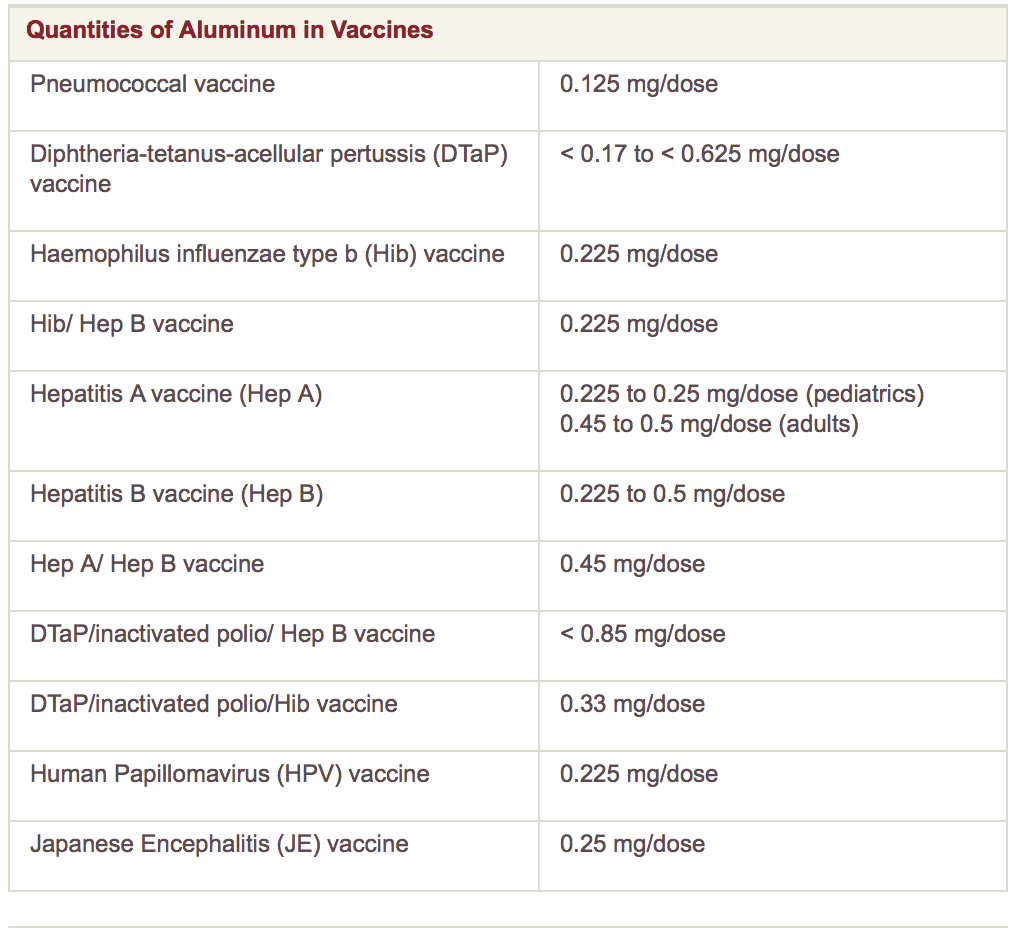
http://www.chop.edu/service/vaccine-education-center/vaccine-safety/vaccine-ingredients/aluminum.html
Autism Spectrum Disorders and Aluminum Vaccine Adjuvants – 2014
“In regard to the risk of adjuvant toxicity in children, the following should be noted: (i) children should not be viewed as “small adults” as their unique physiology makes them more vulnerable to toxic insults; (ii) in adult humans Al adjuvants can cause a variety of serious autoimmune and inflammatory conditions including those affecting the brain, yet children are routinely exposed to much higher amounts of Al from vaccines than adults; (iii) compelling evidence has underscored the tight connection between the development of the immune system and that of the brain. Thus, it appears plausible that disruptions of critical events in immune development may also play a role in the establishment of neurobehavioral disorders; (iv) the same immune system components that play key roles in brain development appear to be targeted for impairment by Al adjuvants. In summary, research data suggests that vaccines containing Al may be a contributing etiological factor in the increasing incidence of autism.”
“These current data implicate Al (aluminum) injected in early postnatal life in some CNS alterations that may be relevant for a better understanding of the aetiology of ASD.”
- Kinetics of the inflammatory response following intramuscular injection of aluminum adjuvant – June 2013
“Recent evidence suggests an important role for inflammation in the immune response to aluminum-adjuvanted vaccines.”
- Autoimmune/inflammatory syndrome induced by adjuvants (Shoenfeld’s syndrome): clinical and immunological spectrum – April 2013
“Recently, a new syndrome was introduced, autoimmune/inflammatory syndrome induced by adjuvants (ASIA), that includes postvaccination phenomena, macrophagic myofasciitis, Gulf War syndrome and siliconosis. This syndrome is characterized by nonspecific and specific manifestations of autoimmune disease. The main substances associated with ASIA are squalene (Gulf War syndrome), aluminum hydroxide (postvaccination phenomena, macrophagic myofasciitis) and silicone with siliconosis.”
- Aluminum in the central nervous system (CNS): toxicity in humans and animals, vaccine adjuvants, and autoimmunity – April 2013
“The literature demonstrates clearly negative impacts of aluminum on the nervous system across the age span. In adults, aluminum exposure can lead to apparently age-related neurological deficits resembling Alzheimer’s and has been linked to this disease and to the Guamanian variant, ALS–PDC.”
- How aluminum, an intracellular ROS generator promotes hepatic and neurological diseases: the metabolic tale – April 2013
“This Al-evoked phenomenon is coupled to diminished mitochondrial activity, anerobiosis, and the channeling of α-ketoacids towards anti-oxidant defense. The resulting metabolic reconfiguration leads to fat accumulation and a reduction in ATP synthesis, characteristics that are common to numerous medical disorders. Hence, the ability of Al toxicity to create an oxidative environment promotes dysfunctional metabolic processes in astrocytes and hepatocytes. These molecular events triggered by Al-induced ROS production are the potential mediators of brain and liver disorders.”
“It has recently been proposed that aluminum, commonly used in vaccines as an adjuvant, may be the most significant factor in adverse reactions, and, furthermore, that the nervous system is especially vulnerable to aluminum toxicity.”
“Conclusion: Intensely itching subcutaneous nodules (vaccination granulomas) and contact allergy to aluminium may occur after primary vaccination with the two most commonly used DTP vaccines in Europe. The condition is probably underreported. Symptoms may last for at least 4–5 years but eventually seem to subside.”
“During the past year a new syndrome was introduced and termed ASIA, ‘Autoimmune (Auto-inflammatory) Syndrome induced by Adjuvants’.1 This syndrome assembles a spectrum of immune-mediated diseases triggered by an adjuvant stimulus.2 – 4 The use of medical adjuvants has become common practice and substances such as aluminum adjuvant are added to most human and animal vaccines, while the adjuvant silicone is extensively used for breast implants and cosmetic procedures. Furthermore, ‘hidden adjuvants’ such as infectious material or house molds have also been associated with different immune mediated conditions.”
“In summary, research evidence shows that increasing concerns about current vaccination practices may indeed be warranted. Because children may be most at risk of vaccine-induced complications, a rigorous evaluation of the vaccine-related adverse health impacts in the pediatric population is urgently needed.”
- Wide Variation in Reference Values for Aluminum Levels in Children – Dec 2011, Full Text
“Further studies of aluminum in children are warranted and should be considered as part of the Centers for Disease Control and Prevention Biomonitoring Project.”
- Aluminum in Vaccines- What you should know – Children’s Hospital of Philadelphia, Vaccine Education Center
Monosodium Glutamate (MSG)
(Found in the Influenza, MMRV, Chickenpox, and Shingles Vaccines)
- Used as stabilizers in a few vaccines to help the vaccine remain unchanged when the vaccine is exposed to heat, light, acidity, or humidity. (1)
- The Danger of MSG and How it is Hidden in Vaccines (Dr. Mercola)
- Locomotor and learning deficits in adult rats exposed to monosodium-L-glutamate during early life (April 2000)
- Monosodium glutamate induced convulsions in rats: Influence of route of administration, temperature and age (1991)
“Comment: The combination of MSG and fever or MSG and exercise has a synergistic neurotoxic effect that lowers seizure threshold.”
2-phenoxyethanol
- Used as stabilizers in a few vaccines to help the vaccine remain unchanged when the vaccine is exposed to heat, light, acidity, or humidity. In vaccines, used as an alternative to Thimerosal. (1)
- 2-Phenoxyethanol Material Safety Data Sheet (MSDS) –
“Potential Acute Health Effects: Extremely hazardous in case of eye contact (irritant). Very hazardous in case of skin contact (irritant), of ingestion, of inhalation. Inflammation of the eye is characterized by redness, watering, and itching. Skin inflammation is characterized by itching, scaling, reddening, or, occasionally, blistering. Potential Chronic Health Effects: Extremely hazardous in case of eye contact (irritant). Very hazardous in case of skin contact (irritant), of ingestion, of inhalation. CARCINOGENIC EFFECTS: Not available. MUTAGENIC EFFECTS: Not available. TERATOGENIC EFFECTS: Not available. DEVELOPMENTAL TOXICITY: Not available. The substance is toxic to kidneys, the nervous system, liver. Repeated or prolonged exposure to the substance can produce target organs damage. Repeated or prolonged inhalation of vapors may lead to chronic respiratory irritation.”
- Preservative of choice for Prev(e)nar 13™ in a multi-dose formulation – June 2011
- Immunogenicity of HBV vaccine during stated shelf-life – July 2010
- The relative toxicity of compounds used as preservatives in vaccines and biologics – May 2010
Conclusions: “None of the compounds commonly used as preservatives in US licensed vaccine/biological preparations can be considered an ideal preservative, and their ability to fully comply with the requirements of the US Code of Federal Regulations (CFR) for preservatives is in doubt. Future formulations of US licensed vaccines/biologics should be produced in aseptic manufacturing plants as single dose preparations, eliminating the need for preservatives and an unnecessary risk to patients.”
- Antimicrobial preservative use in parenteral products: past and present – Dec 2007
- Hypersensitivity Reactions to Vaccine Components – Dec 2005 (Free Registration)
- Occupational phenoxyethanol neurotoxicity: a report of three cases – Jan 1990
Antibiotics
(Neomycin, Gentamycin, Polymyxin B, Kanamycin, Streptomycin, Chlortetracycline, Amphotericin B) Note: All of the antibiotics listed above can cause allergic reactions See: Vaccine Allergens per 0.5mL
- Added to some vaccines to prevent the growth of germs (bacteria) during production and storage of the vaccine. No vaccine produced in the United States contains penicillin. (1)
- Allergenic components of vaccines and avoidance of vaccination-related adverse events – Jan 2001
- Varicella vaccination guidelines for adolescents and adults – March 1997
- MMR Vaccine and Neomycin Allergy – Feb 1993
Antimicrobials:beta-Propriolactone
From the Environmental Protection Agency:
“Hazard Summary-Created in April 1992; Revised in January 2000
- “beta-Propiolactone is used for vaccines, tissue grafts, surgical instruments, and enzymes, as a sterilant of blood plasma, water, milk, and nutrient broth, and as a vapor-phase disinfectant in enclosed spaces. Acute (short-term) inhalation exposure to beta-propiolactone causes severe irritation of the eyes, nose, throat, and respiratory tract in humans. Acute dermal exposure may cause irritation of the skin, blistering, or burns in humans. Contact with the eyes may cause permanent corneal opacification. Burns of the mouth and stomach may occur in humans following acute exposure via ingestion. No information is available on the chronic (long-term), reproductive, developmental, or carcinogenic effects of beta-propiolactone in humans. Squamous cell carcinomas of the forestomach have been reported in orally exposed rats. In dermally exposed rodents, skin tumors have been observed. The International Agency for Research on Cancer (IARC) has classified beta-propiolactone as a Group 2B, possible human carcinogen.”
ASo2, ASo3, AS04
- An adjuvent used to stimulate the immune system.
- AS02- comprised of QS-21 and monophosphoryl lipid A (MPL)
- ASo3- one dose contains 10.69 mg squalene, 11.86 mg DL-α-tocopherol, 4.86 mg polysorbate 80
- AS04- comprised of aluminum phosphate and monophosphoryl lipid A (MPL)
- MPL and AS02/AS04 adjuvant patents
CpG (Synthetic DNA)
- Short single-stranded synthetic DNA molecules that contain a cytosine triphosphate deoxynucleotide (“C)” followed by a guaninetriphosphate deoxynucleotide (“G”). The “p” refers to the phosphodiester backbone. It is considered to be a strong adjuvent and may stimulate the development of antibodies against DNA.
- Lymphoid follicle destruction and immunosuppression after repeated CpG oligodeoxynucleotide administration – Jan 2004
- Blood plasmacytoid dendritic cell responses to CpG oligodeoxynucleotides are impaired in human newborns – Sept 2003
“We conclude that beside the reduced production of IFN-γ production by CD4+ T cells and the impaired synthesis of IL-12p70 by myeloid DCs, deficient responses of pDCs also contribute to the immaturity of cell-mediated immunity in human newborns. These findings might be relevant to the increased susceptibility to infections as well as to the use of CpG oligodeoxynucleotides as vaccine adjuvants in the neonatal period.”
Monophosphoryl Lipid A (MPL)
- MPL Product Detail – “An adjuvent derivative of bacterial endotoxin, one of the most potent immunostimulants known”
- Putting endotoxin to work for us: monophosphoryl lipid A as a safe and effective vaccine adjuvant – Oct 2008
- Early-Phase Endotoxin Tolerance: Induction by a Detoxified Lipid A Derivative, Monophosphoryl Lipid A – 1986
“The major obstacle which has limited the clinical application of endotoxin for its beneficial effects has been its toxic side effects. Chemical modification of the endotoxin molecule has resulted in a nontoxic, MPL which, because of its greatly reduced capacity to cause endotoxicity, holds great potential for clinical utilization.”
Squalene – MF59
- Organic compound originally obtained for commercial purposes primarily from shark liver oil, and a biochemical precursor to steroids and cholesterol.
- Induction of lupus autoantibodies by adjuvants – Aug 2003
- The endogenous adjuvant squalene can induce a chronic T-cell-mediated arthritis in rats – June 2000
- Novartis Is Celebrating. Should We? – Dr. Tennpenny
- Vaccine A: The Covert Government Experiment That’s Killing Our Soldiers–and Why GI’s Are Only the First Victims – Book by Gary Matsumoto regarding the Gulf War Syndrome
- New Generation of Vaccine Adjuvents – By Novartis (the company that owns MF59, 2007)
VACCINE COMPONENTS TABLE
The Vaccine Components Table below will give you the ingredients list for each trademarked vaccine.
- Click on each vaccine and you will be taken to the Institute of Vaccine Safety- John’s Hopkins Bloomberg School of Public Health for more information.
click on the vaccine type below to link to the table of vaccine-specific components
| Vaccine Type | Brand Name |
| DT | DT |
| DTaP | Daptacel, Infanrix, Kinrix |
| DTaP and Hib | TriHIBit |
| DTaP, Hepatitis B and IPV | Pediarix |
| DTaP, IPV, Hib | Pentacel |
| Hepatitis A | Havrix, Vaqta |
| Hepatitis B | Engerix-B, Recombivax HB |
| Hepatitis A and B | Twinrix |
| Hib | Hiberix, HibTITER, PedvaxHIB, ActHIB, OmniHIB |
| Hib and Hepatitis B | Comvax |
| HPV | Cervarix, Gardasil |
| Influenza: | Afluria, Agriflu, Fluarix, Fluarix Quad, Flublok |
| Flucelvax, FluLaval, FluLaval Quad, FluMist Quad, Fluvirin | |
| Fluzone, Fluzone High, Fluzone Intradermal, Fluzone Quad | |
| Japanese Encephalitis | Ixiaro, JE-VAX |
| Meningococcal | Menactra, Menomune, Menveo |
| MMR | MMR II |
| MMRV | ProQuad |
| Pneumococcal | Pneumovax 23, Prevnar, Prevnar 13 |
| Polio | IPOL |
| Rabies | Imovax Rabies, RabAvert |
| Rotavirus | Rotarix, RotaTeq |
| Smallpox | Dryvax |
| Td | Tenivac, Td |
| Typhoid | Typhim Vi, Vivotif |
| Tdap | Adacel, Boostrix |
| Varicella (Chickenpox) | Varivax |
PACKAGE INSERTS AND MANUFACTURERS
(from Institute of Vaccine Safety- John’s Hopkins Bloomberg School of Public Health)
- Click on a “Vaccine” and you can read the package insert, click on an “Antigen(s)” and you can read about the disease and vaccine, click on a “Manufacturer” and you will be taken to their website for further information.
VACCINE INGREDIENTS SAFETY STUDIES
from Vaccine Excipient & Media Summary (CDC) (updated October 2018)
- Canadian National Advisory Committee on Immunization. Statement on thimerosal. CanComm Dis Rep. 2003 ;29(ACS-l): 1-10.
- CDC. Thimerosal in vaccines: ajoint statement of the American Academy of Pediatrics and the Public Health Service. MMWR. 1999;48:563-565.
- Fletcher MA. Hessel L. Plotkin SA. Human diploid cell strains (HDCS) viral vaccines. Dev Biol Stand. 1998;93:97-107.
- Grabenstein JD. Immunologic necessities: Diluents. adjuvant.s, and excipients. Hosp Pharm,. 1996;31: 1387-92, 1397-140 l.
- Grabenstein JD. Clinical management of hypersensitivities to vaccine components. Hosp Pharm. 1997;32:77-84.87.
- Hayftick L. The limited in vitro lifetime of human diploid cell strains. up Cell Res. 1965;37:614-636.
- Jacob JP, Jones CM. Bailie JP. Characteristics of a human diploid cell designated MRC-5. Nature. 1970;227(5254): 168-170.
- Jacobs JP. The status of human diploid cell strain MRC-5 as an approved subslTate for the production of viral vaccines. J Biol Stand. 1976;4(2):97-99.
- Offit PA. Jew RK. Addressing parents’s concerns: Do vaccines contain harmful preservative. adjuvants. additives. or residuals. Pediatrics. 2003; 112: 1394-1401.
VACCINE INGREDIENT RESOURCES
- CDC Vaccine Ingredient Fact Sheet
- Center for Disease Control and Prevention
- Institute of Vaccine Safety- John’s Hopkins Bloomberg School of Public Health
- Vaccine Research Library
- Addressing Parents’ Concerns- Do Vaccines Contain Harmful Preservatives, Adjuvants, Additives, or Residuals? (Offit, Paul. Pediatrics Vol. 112 No. 6 December 2003, pp. 1394-1397)

